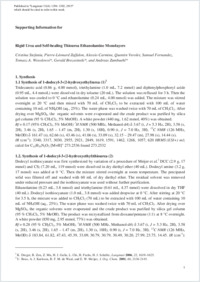Rigid urea and self-healing thiourea ethanolamine monolayers
- Stefaniu, Cristina Max Planck Institute of Colloids and Interfaces, Potsdam, Germany
- Zaffalon, Pierre-Léonard Department of Chemistry, University of Fribourg, Switzerland - National Centre of Competence in Research in Chemical Biology, University of Geneva, Switzerland
- Carmine, Alessio Department of Physical Chemistry, University of Geneva, Quai Ernest-Ansermet 30, 1211 Geneva 4, Switzerland
- Verolet, Quentin Department of Chemistry, University of Fribourg, Chemin du Musée 9, 1700 Fribourg, Switzerland
- Fernandez, Samuel Department of Chemistry, University of Fribourg, Switzerland - National Centre of Competence in Research in Chemical Biology, University of Geneva, Switzerland
- Wesolowski, Tomasz A. Department of Physical Chemistry, University of Geneva, Switzerland
- Brezesinski, Gerald Max Planck Institute of Colloids and Interfaces, Potsdam, Germany
- Zumbuehl, Andreas Department of Chemistry, University of Fribourg, Switzerland - National Centre of Competence in Research in Chemical Biology, University of Geneva, Switzerland
-
03.02.2015
Published in:
- Langmuir. - 2015, vol. 31, no. 4, p. 1296–1302
English
A series of long-tail alkyl ethanolamine analogs containing amide-, urea-, and thiourea moieties was synthesized and the behavior of the corresponding monolayers was assessed on the Langmuir–Pockels trough combined with grazing incidence X-ray diffraction experiments and complemented by computer simulations. All compounds form stable monolayers at the soft air/water interface. The phase behavior is dominated by strong intermolecular headgroup hydrogen bond networks. While the amide analog forms well-defined monolayer structures, the stronger hydrogen bonds in the urea analogs lead to the formation of small three-dimensional crystallites already during spreading due to concentration fluctuations. The hydrogen bonds in the thiourea case form a two-dimensional network, which ruptures temporarily during compression and is recovered in a self-healing process, while in the urea clusters the hydrogen bonds form a more planar framework with gliding planes keeping the structure intact during compression. Because the thiourea analogs are able to self-heal after rupture, such compounds could have interesting properties as tight, ordered, and self-healing monolayers.
- Faculty
- Faculté des sciences et de médecine
- Department
- Département de Chimie
- Language
-
- English
- Classification
- Chemistry
- License
-
License undefined
- Identifiers
-
- RERO DOC 255831
- DOI 10.1021/la5039987
- Persistent URL
- https://folia.unifr.ch/unifr/documents/304428
Other files
Statistics
Document views: 107
File downloads:
- pdf: 333
- Supplementary material: 155

